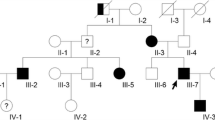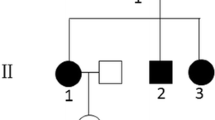Abstract
A few cases of cerebral cavernous malformation (CCM) have been reported in Chinese families with different mutations during the past decade. Herein, we report a case of CCM in a proband in a Chinese family, for whom the mutation type of the CCM remains to be identified. The proband of the family presented a range of clinical symptoms and features that included paralysis, aphasia, multiple lesions in the brain, and cutaneous capillary–venous malformations. PCR was performed to amplify all of the coding exons of the three CCM genes (CCM1, CCM2, and CCM3) in the proband and revealed a heterozygous T deletion in exon 15 (c.1542delT) of CCM1 gene. Targeted mutation analysis in family members demonstrated that this mutation segregated with the disease in the family. This is the first report of a heterozygous CCM1 deletion mutation. Our findings provide a new CCM gene mutation profile in a Chinese family which will be of significance in genetic counseling for CCM.


Similar content being viewed by others
References
Barker FG 2nd, Amin-Hanjani S, Butler WE et al (2001) Temporal clustering of hemorrhages from untreated cavernous malformations of the central nervous system. Neurosurgery 49:15–24, discussion 24–15
Bergametti F, Denier C, Labauge P et al (2005) Mutations within the programmed cell death 10 gene cause cerebral cavernous malformations. Am J Hum Genet 76:42–51
Cave-Riant F, Denier C, Labauge P et al (2002) Spectrum and expression analysis of KRIT1 mutations in 121 consecutive and unrelated patients with Cerebral Cavernous Malformations. Eur J Hum Genet 10:733–740
Chen DH, Lipe HP, Qin Z, Bird TD (2002) Cerebral cavernous malformation: novel mutation in a Chinese family and evidence for heterogeneity. J Neurol Sci 196:91–96
D’Angelo R, Marini V, Rinaldi C et al (2011) Mutation analysis of CCM1, CCM2 and CCM3 genes in a cohort of Italian patients with cerebral cavernous malformation. Brain Pathol 21:215–224
Denier C, Labauge P, Brunereau L et al (2004) Clinical features of cerebral cavernous malformations patients with KRIT1 mutations. Ann Neurol 55:213–220
Denier C, Labauge P, Bergametti F et al (2006) Genotype-phenotype correlations in cerebral cavernous malformations patients. Ann Neurol 60:550–556
Felbor U, Sure U, Grimm T, Bertalanffy H (2006) Genetics of cerebral cavernous angioma. Zentralbl Neurochir 67:110–116
Ferroli P, Casazza M, Marras C, Mendola C, Franzini A, Broggi G (2006) Cerebral cavernomas and seizures: a retrospective study on 163 patients who underwent pure lesionectomy. Neurol Sci 26:390–394
Haghighi A, Fathi D, Shahbazi M, Motahari MM, Friedman B (2013) Identification of a c.601C>G mutation in the CCM1 gene in a kindred with multiple skin, spinal and cerebral cavernous malformations. J Neurol Sci 334:97–101
Ji BH, Qin W, Sun T, Feng GY, He L, Wang YJ (2006) A novel deletion mutation in CCM1 gene (krit1) is detected in a Chinese family with cerebral cavernous malformations. Yi Chuan Xue Bao 33:105–110
Labauge P, Laberge S, Brunereau L, Levy C, Tournier-Lasserve E (1998) Hereditary cerebral cavernous angiomas: clinical and genetic features in 57 French families. Soc Fr Neurochir Lancet 352:1892–1897
Li J, Yang T, Wang L et al (2009) Whole genome distribution and ethnic differentiation of copy number variation in Caucasian and Asian populations. PLoS ONE 4:e7958
Liquori CL, Berg MJ, Siegel AM et al (2003) Mutations in a gene encoding a novel protein containing a phosphotyrosine-binding domain cause type 2 cerebral cavernous malformations. Am J Hum Genet 73:1459–1464
Mao Y, Zhao Y, Zhou LF et al (2005) A novel gene mutation (1292 deletion) in a Chinese family with cerebral cavernous malformations. Neurosurgery 56:1149–1153, discussion 1149–1153
Moriarity JL, Wetzel M, Clatterbuck RE et al (1999) The natural history of cavernous malformations: a prospective study of 68 patients. Neurosurgery 44:1166–1171, discussion 1172–1163
Otten P, Pizzolato GP, Rilliet B, Berney J (1989) 131 cases of cavernous angioma (cavernomas) of the CNS, discovered by retrospective analysis of 24535 autopsies. Neurochirurgie 35:82–83, 128–131
Porter PJ, Willinsky RA, Harper W, Wallace MC (1997) Cerebral cavernous malformations: natural history and prognosis after clinical deterioration with or without hemorrhage. J Neurosurg 87:190–197
Riant F, Bergametti F, Ayrignac X, Boulday G, Tournier-Lasserve E (2010) Recent insights into cerebral cavernous malformations: the molecular genetics of CCM. FEBS J 277:1070–1075
Rigamonti D, Drayer BP, Johnson PC, Hadley MN, Zabramski J, Spetzler RF (1987) The MRI appearance of cavernous malformations (angiomas). J Neurosurg 67:518–524
Rigamonti D, Hadley MN, Drayer BP et al (1988) Cerebral cavernous malformations. Incidence and familial occurrence. N Engl J Med 319:343–347
Robinson JR, Awad IA, Little JR (1991) Natural history of the cavernous angioma. J Neurosurg 75:709–714
Sirvente J, Enjolras O, Wassef M, Tournier-Lasserve E, Labauge P (2009) Frequency and phenotypes of cutaneous vascular malformations in a consecutive series of 417 patients with familial cerebral cavernous malformations. J Eur Acad Dermatol Venereol 23:1066–1072
Surucu O, Sure U, Gaetzner S et al (2006) Clinical impact of CCM mutation detection in familial cavernous angioma. Childs Nerv Syst 22:1461–1464
Toldo I, Drigo P, Mammi I, Marini V, Carollo C (2009) Vertebral and spinal cavernous angiomas associated with familial cerebral cavernous malformation. Surg Neurol 71:167–171
Tsutsumi S, Ogino I, Miyajima M et al (2013) Genomic causes of multiple cerebral cavernous malformations in a Japanese population. J Clin Neurosci 20:667–669
Verlaan DJ, Siegel AM, Rouleau GA (2002) Krit1 missense mutations lead to splicing errors in cerebral cavernous malformation. Am J Hum Genet 70:1564–1567
Wang X, Liu XW, Lee N et al (2013) Features of a Chinese family with cerebral cavernous malformation induced by a novel CCM1 gene mutation. Chin Med J (Engl) 126:3427–3432
Xu YL, Zhao JZ, Wu BQ, Zhong HH, Wang S, Heng WJ (2003) A novel Krit-1 mutation in Han family with cerebral cavernous malformation. Zhonghua Bing Li Xue Za Zhi 32:220–225
Zabramski JM, Wascher TM, Spetzler RF et al (1994) The natural history of familial cavernous malformations: results of an ongoing study. J Neurosurg 80:422–432
Zhao Y, Xie L, Li P et al (2011) A novel CCM1 gene mutation causes cerebral cavernous malformation in a Chinese family. J Clin Neurosci 18:61–65
Acknowledgments
The authors thank Dr. Teng Zhao for the assistance in investigating the pedigree. The authors also thank Dr. Jinguo Gao for the help with the laboratory results.
Conflict of Interest
There are no conflicts of interest.
Authors’ Contributions
Jingyao Liu and Hui Zhu carried out the molecular genetic studies, participated in the sequence alignment, and drafted the manuscript. Rensheng Zhang participated in the sequence alignment. Xuemin Feng participated in the design of the study. Chunkui Zhou and Guibo Li conceived of the study, participated in its design and coordination, and helped to draft the manuscript. All authors read and approved the final manuscript.
Author information
Authors and Affiliations
Corresponding author
Additional information
Hui Zhu and Yingjie Guo contributed equally to this work.
Rights and permissions
About this article
Cite this article
Zhu, H., Guo, Y., Feng, X. et al. Familial Cerebral Cavernous Angiomas: Clinical and Genetic Features in a Chinese Family with a Frame-Shift Mutation in the CCM1 Gene (krit1). J Mol Neurosci 54, 790–795 (2014). https://doi.org/10.1007/s12031-014-0415-3
Received:
Accepted:
Published:
Issue Date:
DOI: https://doi.org/10.1007/s12031-014-0415-3




